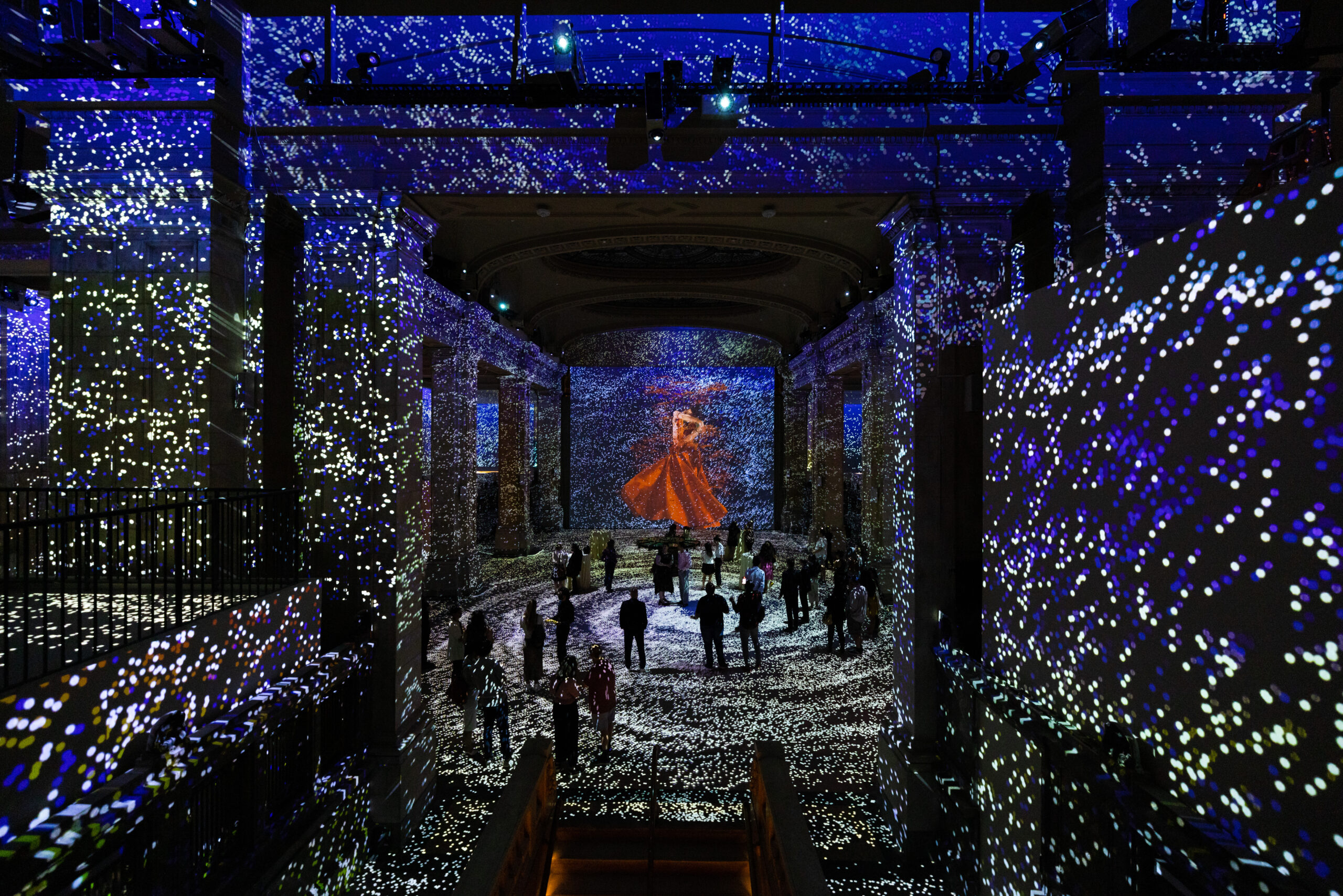
Rendering of Gustav Klimt: Gold in Motion at the Hall des Lumières, New York. At center is Portrait of Adele Bloch-Bauer I by Klimt (1862–1918), 1907, with Portrait of Adele Bloch Bauer II, 1912, duplicated on either side of the entrance to the space. All photographs and renderings courtesy of Hall des Lumières, © Culturespaces.
In terms of a cultural trend, something possibly important is afoot in a spectacle titled Gustav Klimt: Gold in Motion, which recently opened in lower Manhattan at the Hall des Lumières. Every day, hundreds, even thousands of people pay upwards of thirty-five dollars to spend an hour in a darkened space, looking not at original art but at digitized reproductions of Klimt paintings projected across the interior walls of the abandoned, century-old Emigrant Industrial Savings Bank at 49 Chambers Street. These images dance and swell and vanish as suddenly as they appear, to the rather loud accompaniment of Beethoven, Puccini, and Debussy. Visitors, meanwhile, stand or pace about or, most commonly, sit on the floor, sharing the “experience” with scores of other similarly enraptured spectators.
The impresarios responsible for this son et lumière extravaganza are Bruno Monnier, CEO of Culturespaces, a Paris-based firm that describes itself as “the leading private cultural operator,” and Gianfranco Ianuzzi, a seventy-five-year-old Venetian digital artist. Together the pair have been responsible for similar exhibitions devoted to Paul Cézanne and Vincent van Gogh, among others. Comparable spectacles have been staged in locations as diverse as Paris, Amsterdam, Seoul, and Dubai.

Rendering of the interior of the Hall des Lumières.
There is an element of almost barbaric gorgeousness to the present show, which does full justice to the exotic, neo-byzantine spirit in which Klimt created his best-known works. A number of the master’s moody evocations of Viennese faces of long ago float across our line of vision, followed by another segment that features his landscapes. But, despite its title, the show ranges far beyond Klimt. The first and longest part is indeed devoted to the Viennese painter; but it also touches on the Vienna Secession and the works of Egon Schiele, a rather younger and quite different artist. Then the presentation shifts gears even more emphatically, flowing seamlessly into other exhibitions. The first is a showcase of the art of postwar painter Friedensreich Hundertwasser, who died in 2000 and whose main connection to Klimt is that they were both from Vienna and that some of the younger artist’s imagery bears a formal resemblance to the aesthetics of the Secession. From there the show shifts to a respectful evocation of the Emigrant Bank, a splendid Beaux-Arts building, before moving on again to a creative, new-age sequence of breakdancers and Balinese dancers, and ending with a section called Recoding Entropia, a suggestively arty compilation of images by Francois Vautier.

Rendering of 5 Movements, an audiovisual artwork designed and directed by Nohlab and produced by Culturespaces Digital, 2022.
In purely visual terms, Gustav Klimt: Gold in Motion (as well as the other shows) is quite something. At the same time, however, its educational value is nearly nonexistent. To claim that it is an infomercial would be giving it more credit than it deserves, since infomercials actually do impart a modicum of information, such as it is. Visitors are best advised to consume the present show as a spirited evocation of the Austrian artist, a dazzling barrage of multi-hued images that vanish before the eye can fully process them in any critical way. It shares with all art documentaries, but to an unusually tyrannous degree, the impulse to dictate how viewers must see the art in question. In real life, no two people have ever looked at the same work in quite the same way. In the present instance, we are all compelled to see these paintings through the eyes of someone else. Added to this constraint is the fact that the dizzying proliferation of images surrounds the viewer in a 360-degree circumference, as well as in separate chambers of the bank, in such a way that no one person can take it all in simultaneously.
It is an easy thing to mock the implicit pretensions of this spectacle, with its one-world, multi-culti self-satisfaction, a mood that the visitor implicitly endorses and literally buys into with his ticket purchase. (There is even a designated “selfie room” for those who cannot constrain the need to take one.) The show represents the latest form of idolatrous devotion to the cult of visual artists, a tendency that, one might argue, began with the adulation of Michelangelo—il divino—in Rome in the latter half of the sixteenth century. At the same time, one cannot deny that the hour passes pleasantly enough, and it may be that this spectacle is just the thing to awaken, in some of the children who attend it, the first stirrings of a deeper and truer appreciation of the fine arts.

Rendering of Klimt’s Water Serpents II (Friends), 1904–1907, from the exhibition.

